Bayfield 29
The bayfield 29 is a 29.0ft cutter designed by ted gozzard and built in fiberglass by bayfield boat yard ltd. (can) between 1978 and 1983., 350 units have been built..
The Bayfield 29 is a heavy sailboat which is a good performer. It is very stable / stiff and has a low righting capability if capsized. It is best suited as a coastal cruiser. The fuel capacity is originally very small. There is a very short water supply range.

Bayfield 29 for sale elsewhere on the web:

Main features
| Model | Bayfield 29 | ||
| Length | 29 ft | ||
| Beam | 10.17 ft | ||
| Draft | 3.50 ft | ||
| Country | Canada (North America) | ||
| Estimated price | $ 0 | ?? |
Login or register to personnalize this screen.
You will be able to pin external links of your choice.

See how Sailboatlab works in video
| Sail area / displ. | 18.24 | ||
| Ballast / displ. | 42.25 % | ||
| Displ. / length | 308.06 | ||
| Comfort ratio | 20.88 | ||
| Capsize | 2.12 |
| Hull type | Monohull long keel | ||
| Construction | Fiberglass | ||
| Waterline length | 21.75 ft | ||
| Maximum draft | 3.50 ft | ||
| Displacement | 7100 lbs | ||
| Ballast | 3000 lbs | ||
| Hull speed | 6.25 knots |

We help you build your own hydraulic steering system - Lecomble & Schmitt
| Rigging | Cutter | ||
| Sail area (100%) | 468 sq.ft | ||
| Air draft | 0 ft | ?? | |
| Sail area fore | 252 sq.ft | ||
| Sail area main | 167.75 sq.ft | ||
| I | 36 ft | ||
| J | 14 ft | ||
| P | 30.50 ft | ||
| E | 11 ft |
| Nb engines | 1 | ||
| Total power | 15 HP | ||
| Fuel capacity | 19 gals |
Accommodations
| Water capacity | 20 gals | ||
| Headroom | 0 ft | ||
| Nb of cabins | 0 | ||
| Nb of berths | 0 | ||
| Nb heads | 0 |
Builder data
| Builder | Bayfield Boat Yard Ltd. (CAN) | ||
| Designer | Ted Gozzard | ||
| First built | 1978 | ||
| Last built | 1983 | ||
| Number built | 350 |
Modal Title
The content of your modal.
Personalize your sailboat data sheet
BAYFIELD 29 Detailed Review
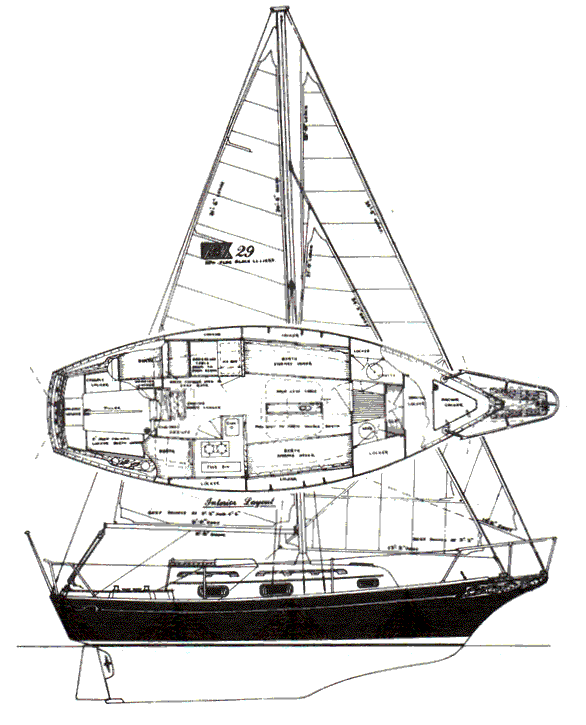
If you are a boat enthusiast looking to get more information on specs, built, make, etc. of different boats, then here is a complete review of BAYFIELD 29. Built by Bayfield Boat Yard Ltd. (CAN) and designed by Ted Gozzard, the boat was first built in 1978. It has a hull type of Long Keel and LOA is 8.84. Its sail area/displacement ratio 20.33. Its auxiliary power tank, manufactured by Yanmar, runs on Diesel.
BAYFIELD 29 has retained its value as a result of superior building, a solid reputation, and a devoted owner base. Read on to find out more about BAYFIELD 29 and decide if it is a fit for your boating needs.
Boat Information
Boat specifications, sail boat calculation, rig and sail specs, auxillary power tank, accomodations, contributions, who designed the bayfield 29.
BAYFIELD 29 was designed by Ted Gozzard.
Who builds BAYFIELD 29?
BAYFIELD 29 is built by Bayfield Boat Yard Ltd. (CAN).
When was BAYFIELD 29 first built?
BAYFIELD 29 was first built in 1978.
How long is BAYFIELD 29?
BAYFIELD 29 is 6.63 m in length.
What is mast height on BAYFIELD 29?
BAYFIELD 29 has a mast height of 9.3 m.
Member Boats at HarborMoor
Review of Bayfield 29
Basic specs..
The hull is made of fibreglass. Generally, a hull made of fibreglass requires only a minimum of maintenance during the sailing season. And outside the sailing season, just bottom cleaning and perhaps anti-fouling painting once a year - a few hours of work, that's all.
The boat is equipped with 75.0 liter fresh water capacity.
The Bayfield 29 is equipped with a long keel. A full keel provide a better directional stability than a similar boat with a fin keel; on the other hand, better directional stability means also that the boat is more difficult to handle in a harbour with less space.
The boat can enter even shallow marinas as the draft is just about 1.07 - 1.17 meter (3.51 - 3.81 ft) dependent on the load. See immersion rate below.
Bayfield 29 is typically equipped with an inboard Yanmar 2GM diesel engine at 15 hp (11 kW). Calculated max speed is about 5.0 knots
The fuel tank has a capacity of 75.0 liters (19 US gallons, 16 imperial gallons).
Sailing characteristics
This section covers widely used rules of thumb to describe the sailing characteristics. Please note that even though the calculations are correct, the interpretation of the results might not be valid for extreme boats.
What is Capsize Screening Formula (CSF)?
The capsize screening value for Bayfield 29 is 2.12, indicating that this boat would not be accepted to participate in ocean races.
What is Theoretical Maximum Hull Speed?
The theoretical maximal speed of a displacement boat of this length is 6.2 knots. The term "Theoretical Maximum Hull Speed" is widely used even though a boat can sail faster. The term shall be interpreted as above the theoretical speed a great additional power is necessary for a small gain in speed.
The immersion rate is defined as the weight required to sink the boat a certain level. The immersion rate for Bayfield 29 is about 137 kg/cm, alternatively 771 lbs/inch. Meaning: if you load 137 kg cargo on the boat then it will sink 1 cm. Alternatively, if you load 771 lbs cargo on the boat it will sink 1 inch.
Sailing statistics
This section is statistical comparison with similar boats of the same category. The basis of the following statistical computations is our unique database with more than 26,000 different boat types and 350,000 data points.
What is Motion Comfort Ratio (MCR)?
What is L/B (Length Beam Ratio)?
What is a Ballast Ratio?
What is Displacement Length Ratio?
What is SA/D (Sail Area Displacement ratio)?
Maintenance
When buying anti-fouling bottom paint, it's nice to know how much to buy. The surface of the wet bottom is about 14m 2 (150 ft 2 ). Based on this, your favourite maritime shop can tell you the quantity you need.
Are your sails worn out? You might find your next sail here: Sails for Sale
If you need to renew parts of your running rig and is not quite sure of the dimensions, you may find the estimates computed below useful.
| Usage | Length | Diameter | ||
| Mainsail halyard | 24.6 m | (80.5 feet) | 8 mm | (5/16 inch) |
| Jib/genoa halyard | 24.6 m | (80.5 feet) | 8 mm | (5/16 inch) |
| Spinnaker halyard | 24.6 m | (80.5 feet) | 8 mm | (5/16 inch) |
| Jib sheet | 8.8 m | (29.0 feet) | 10 mm | (3/8 inch) |
| Genoa sheet | 8.8 m | (29.0 feet) | 10 mm | (3/8 inch) |
| Mainsheet | 22.1 m | (72.5 feet) | 10 mm | (3/8 inch) |
| Spinnaker sheet | 19.4 m | (63.8 feet) | 10 mm | (3/8 inch) |
| Cunningham | 3.4 m | (11.0 feet) | 8 mm | (5/16 inch) |
| Kickingstrap | 6.7 m | (22.0 feet) | 8 mm | (5/16 inch) |
| Clew-outhaul | 6.7 m | (22.0 feet) | 8 mm | (5/16 inch) |
This section is reserved boat owner's modifications, improvements, etc. Here you might find (or contribute with) inspiration for your boat.
Do you have changes/improvements you would like to share? Upload a photo and describe what you have done.
We are always looking for new photos. If you can contribute with photos for Bayfield 29 it would be a great help.
If you have any comments to the review, improvement suggestions, or the like, feel free to contact us . Criticism helps us to improve.
Bayfield 29
no photos yet ⛵️
About the bayfield 29 .
The Bayfield 29 is a recreational keelboat, built predominantly of fibreglass, with wood trim. It has a cutter rig with anodized aluminum spars, a clipper bow, a conventional transom, a keel-mounted rudder controlled by a tiller, or optional Edson wheel, and a fixed long keel. The design has no provisions for a spinnaker and has been noted as having a small cockpit. It has a book displacement of 7,100 lb (3,221 kg) and carries 3,000 lb (1,361 kg) of ballast. Company president Jake Rogerson noted in 1985 that the boats were over-built and the actual displacement is probably closer to 8,500 lb (3,856 kg). The boat has a draft of 3.50 ft (1.07 m) with the standard keel. The boat is fitted with a Japanese Yanmar 2GM diesel engine of 15 hp (11 kW) for docking and manoeuvring. The fuel tank holds 19 U.S. gallons (72 L; 16 imp gal) and the fresh water tank has a capacity of 20 U.S. gallons (76 L; 17 imp gal). The design has sleeping accommodation for five people, with two straight settees in the main cabin, one of which converts to a double and two quarter berths aft, one on each side. Unconventionally there is no bow "V" berth and instead the bow is occupied by a large head, instead. The galley is located on the starboard side just forward of the companionway ladder. The galley is "L"-shaped and is equipped with a two-burner alcohol-fired stove, an icebox and a stainless steel sink. A navigation station is opposite the galley, on the port side. The cabin is an open plan design, but has wooden panels built into the gallery counter and the chart table, that can be raised for privacy. The interior was delivered with unfinished teak. The design has a PHRF-LO racing average handicap of 213.
Canada United States
7,100 lb (3,221 kg)
3.50 ft (1.07 m)
Ted Gozzard
Bayfield Boat Yard
29.00 ft (8.84 m)
21.75 ft (6.63 m)
10.17 ft (3.10 m)
Yanmar 2GM 15 hp (11 kW) diesel engine
3,000 lb (1,361 kg)
keel-mounted rudder
Rig / Sails
167.75 sq ft (15.584 m2)
252.00 sq ft (23.412 m2)
419.75 sq ft (38.996 m2)
36.00 ft (10.97 m)
14.00 ft (4.27 m)
30.50 ft (9.30 m)
11.00 ft (3.35 m)
Bow and Stern
Adventures in a bayfield 29.

Bayfield 29 — An early review
I’ve had a few weeks with the new boat (Bayfield 29, la Princesa …until I change the name in a few weeks), and I’m getting a good feel for her.
Firstly, I don’t have any buyers remorse. At least not yet. I’m rather pleased with the design in general.
Under sail:
She sails remarkably well in light air. Not race boat fast; but certainly a lot better than I expected from a full keel, rather full body cutter. Under the asymmetrical spinnaker she would do three knots in around six knots indicated wind (masthead anemometer), and if I was willing to settle for two knots of speed (and I often am), I could probably keep her moving at that pace on most points of sail under working canvas in any but the lightest wind (perhaps I’m overstating the case; but given my experience so far I don’t think by much).
She is perfectly happy in heavyish weather provided she gets a reef in the main by around 20 knots wind or so. I’ve had her in the high twenties pushing thirty (apparent, indicated) under one reef and both head-sails (I’m not sure if they are the original sizes or not) and there was a fair amount of weather helm; but it wasn’t unmanageable or uncomfortable, although a second reef probably wouldn’t have been a bad idea. I haven’t explored the full range of capability yet (I JUST bought the boat); but I’m willing to bet that with the second (fairly deep) reef, 40 knots of wind will be somewhat anti-climatic (although the wave action that goes along with 40 knots might not be pleasant…I’m not rushing to find out). I find her quite stiff (a benefit of that rotund body, I suspect), dry, and comfortable throughout the twenties with probably three to four foot Chesapeake waves.
Under Power:
No trouble handling under power in forward. She will turn within her own length to port (edit: I THINK to port…My recollection is suddenly challenging that direction). In reverse I now understand all the full keel complaints. I’m sure I’ll figure it out eventually; but I haven’t yet. I back into my slip; but I am using warping lines more than engine power at the moment. It’s a bit more work; but even single handed in a cross breeze I know I can get the boat in that way. I have watched some maestros under power, though, and I know it can be done with some more experience.
Cockpit and Deck:
The cockpit is deeper than I would like. It feels quite secure; but I need a huge cushion to sit high enough for good visibility (and I’m not a tiny man!). The seat coamings are practically vertical, the seat bottoms are too narrow, and the foot well area is so wide it is difficult to brace against the opposite seat. Happily, with the cushion I’m high enough I can see, and the boat is stiff enough that bracing isn’t as big a deal as it could be. But if each of the seats was a few inches wider, and the foot well was 6-8 inches narrower, and the back rest was angled a bit, the cockpit would be much more comfortable. Also I find it a little tricky to have one person at the tiller while another is tending the sheets as they both want to occupy the same space. This can be worked around, and with experimentation I am figuring it out; but some more thought here wouldn’t have been out of place. The cockpit also seems designed to hold a tremendous amount of water, with only two average size (1.5″ maybe? Less?) drains to let it all out. Hopefully if I’m ever out in conditions likely to flood the cockpit the cabin hatches are in, and the engine room hatch gasketing is more robust than it looks. Before serious contemplation of an offshore trip I’d have to think long and hard about putting in more cockpit drainage. As deep as the cockpit is, boat handling would be a challenge with more than a couple people in it.
While we are in the cockpit, I’d also like to say that I am not a big fan of having halyards run aft. Running the two head-sail halyards aft is pointless because I have roller furling (which is pretty nice, by the way). And the mains’l halyard is almost as pointless as the main seems to often get hung up on the lazyjacks going both up and down, which requires going to the mast to guide things along. While this is probably correctable either through a reconfiguration of the lazyjacks, or a change in technique on my part, what is not easily correctable is the reefing lines which are at the base of the boom. There is little point in trying to rig them to the cockpit as it is still necessary to be at the mast to get the reefing hook into the tack (although I suppose I could try and rig single line reefing…I’ll think about it). The outhaul and topping lift are also controlled at the mast. What the heck, they might as well have left the main halyard there too! I’ll think about it for the next year or so, I guess, and see if it bugs me enough to make changes. This is one of those things where the current setup appears ideal for the single hander, but I find it quite the opposite. It’s also a shame the boom wasn’t a few inches higher as this is a headache waiting to happen (a foot higher might permit standing headroom under the dodger and bimini)!
One other gripe, although this seems to also be common across most modern designs, is that one of the shroud chainplates on either side goes through the deck. The inner shrouds are attached to the house sides, and with that near vertical orientation they don’t seem to leak. The outer shrouds, though, poke a hole through the damn deck. Why? This is certainly NOT a racing boat, so a couple extra inches of sheeting angle won’t matter, especially since neither head sail extends aft of the mast. If Bayfield would have just moved the chainplates to the hull side I’m willing to bet that any water leakage, even with old caulking, would be minimal. As it is I’m going to need to caulk them up when I do my winter refit. The standing rigging will need to be replaced at some point, and I may consider moving those chain plates out at that time. I need to do research first, though, as there are likely to be unintended consequences.
The good news is the side decks are reasonably wide, the life lines are high enough to be safe, the foredeck feels secure, and the motion of the boat is quite comfortable.
Moving on to the interior we have what is, in many ways, a brilliant layout. By eliminating the v-berth (which typically in small boats becomes a catch all junk room) we not only get rid of the least comfortable berth aboard, we suddenly have room for a remarkably spacious head for a small boat. It is quite comfortable. Forward of the head is a hanging/storage locker, and further forward a huge anchor locker. There is even a funny little cushioned seat in the head, which I haven’t been able to find a point to; but it looks pretty cool even if I’m unlikely to ever sit on it. With the head further forward, we open up the main cabin. There is a centerline table with fold up leafs. On the starboard side is a berth that pulls out into a double, with a regular settee on the port side. Aft further is a half bulkhead that separates the galley (starboard) and chart table (decently sized to port). Partitions slide up from the half bulkhead to really separate the main cabin from what I’m calling the “working” (galley/navigation) cabin if the need for privacy and separation would arise (for instance, on a passage with sleeping crew). Aft of both the galley and chart table are a pair of quarter berths, port (a little too short) and starboard (plenty long). Four opening portlights plus the hatch in the head allow for decent ventilation. I’m 5’10” tall and I have standing headroom throughout, barely, although I have bumped my head a few times walking through the door to the head. Stowage is quite reasonable (I’m still experimenting on how best to utilize it). Water tankage is fine for a week or so (25 or 30 gallons I’m guessing); but could probably stand to be increased for any extended trips, especially considering the waste associated with a pressure water system (there is currently no system implemented for non-pressure water, although this is on my to-do list). The interior is teak, which some people like (me, for one), and others find gloomy. Build quality seems generally very decent.
Brilliant or not, I have a couple gripes about the interior as well. Well, I have one BIG gripe. Once again Ted Gozzard (or perhaps Bayfield yachts themselves) had an ergonomic brain fart. The settees, when in “couch” mode (that is, the seat backs are down), are too narrow, and it constantly feels like you are sitting on the edge of your seat. I guess this is OK for eating at the table; but not my cup of tea for just relaxing in the cabin. Raise the seat backs into bunk mode and they are as comfortable as any bunk I’ve personally been on. I have a few thoughts on how to make the settees more comfortable; but it will take a little experimentation. I’m going to try to avoid major surgery, or having to make new cushions ($$$); but I might not get away with that. Given that this boat will eventually be my home, though, the situation needs to be worked on a bit, and it deserves to have a few dollars thrown at it.
Ice melts fast in the ice-box. I think I’ll probably turn it into dry storage and pick up an Engle or something (I’ll snug it down into the starboard quarter berth or something, I guess).
Mechanicals:
The engine is a Yanmar 2GM, is about thirteen horsepower (although I can not get it up to max continuous RPM of 3400, meaning I’m not getting all the ponies), and seems to push the boat along just fine. When the wind and seas are calm I am just about getting to hull speed at maybe 2800 RPM (indicated). When the wind and waves are well up, I’ve been held back to as little as four knots over the ground (the knotmeter is not giving realistic numbers, so I’m defaulting to GPS…it should be correct within a quarter to maybe half knot or so, I think) at my max achievable RPM of three thousand. A few extra horsepower when the wind is blowing would not be unwelcome; but I think I’m getting an adequate amount. I think twenty horse power would have been a better choice; but not nearly better enough to consider spending the money to repower. I haven’t figured out fuel consumption, yet; but it is modest. The standard alternator is 35 amps. Given the horsepower, I’m not sure if it is reasonable to go much bigger which might put a practical limit on battery capacity.
Engine access is terrific, both through a hatch in the cockpit (although I wonder what would happen if the cockpit got flooded) and by removing the companionway steps, through the cabin. My only complaint is that the oil dipstick is in an awkward location which discourages checking it daily; but that is part of the discipline. I had a cooling problem a few days ago, so I pulled the water pump off to check the impeller and replace the belts. It was easy. I haven’t done any other maintenance on it yet; but outside of changing the oil (I think the old oil is sucked up through the dipstick port with a pump), most everything looks pretty easy to handle. Since there isn’t an hour meter on the motor and I don’t know when any scheduled preventative maintenance was last done, I’m planning on doing pretty much everything on the scheduled maintenance list to effectively reset the clock to zero before hauling in a few weeks for the winter. I may put in an hour meter at some point to help keep track, too.
I have a pair of Group 24 deep cycle batteries, in two banks. I’d like to at least double my amp capacity. It is not immediately obvious the best way to shoe-horn in more batteries, although I have a couple ideas. A tape measure will be my best friend for awhile. Given the smallish alternator, solar charging will be a good idea.
Boat options:
Air-conditioning! It is probably twenty years old and blows cool, but not cold air. I’m going to see if I can fix this up. As a soon to be live-aboard I believe I will replace this unit if I can’t get it working better (might just need a charge, or perhaps a good cleaning). It does get hot here in the Chesapeake!
Propane on demand hot water heater. It works, and generates scalding hot water. But it seems to take awhile to get going, and the water tanks are small enough that running the faucet while waiting for the hot water to show up seems like a terrible waste of fresh water. Taking a hot shower on a cool morning is pretty damn awesome, though! (Although there are pitfalls to showering aboard). I need to redo the propane lines (it’s a trust issue), so I may decide to get rid of the water heater. It will be kind of odd having a hot water faucet on each of the sinks without any hot water; but such is life. I can use my portable pump up sprayer for showers (it works well) by either solar heating the container or just boiling a pot of water.
Deck wash-down pump. The water around here is muddy. It’s very cool to be able to spray off the chain and deck after raising anchor. Very cool.
Propane stove. I guess the Bayfields came with Origo alcohol stoves; but my 29 has a Kenyon two burner propane job. I’m not a big foodie and I tend to cook simple meals, so this isn’t that big a deal to me. Gas is nice, though. Unfortunately, the stove is not gimballed (and it doesn’t have an oven, although that is of limited interest to me), and there is no easy way to install a permanent gimballed stove without doing major galley surgery and probably sacrificing the starboard quarter berth (which isn’t likely to get used much; but it might be important if it comes time to sell the boat down the road). I have a thought on how to inexpensively build a portable/removable gimballed stove sort of like the old Sea Cook stove, so when the time comes I’m sure I’ll be OK. There is currently a six pound propane tank hanging off the stern pulpit. Before doing any long distance cruising it might make sense to get another.
Conclusion:
While I have a few gripes, I find the boat meets my needs about as well, better really, as could be expected. There are always compromises; but in a sub-thirty foot live-aboard (take away the pulpit, it is probably closer to 27′) I don’t think I could ask for much more. I don’t know if many Bayfield 29s are out doing ocean crossings; but while the design might not be the best choice for a trip around the Horn, I don’t see any reason why she shouldn’t be perfectly capable and comfortable for seasonally appropriate passages providing some modest updating is done; although my experience in the matter is a bit limited.
She makes me smile when I look at her, and even though she looks a little tired at the moment, she gets a lot of compliments. She is thirty years old, and as is reasonably expected, her systems and cosmetics need some attention. Getting old sucks; but I don’t see any reason why “ la Princesa ” (I’m looking forward to the new name) can not be restored to full glory with a modest amount of elbow grease.
Feed from: http://continuousmoon.blogspot.com/
Share this:
- Click to print (Opens in new window)
- Click to share on Facebook (Opens in new window)
- Click to share on Twitter (Opens in new window)
- Click to email a link to a friend (Opens in new window)
- Click to share on LinkedIn (Opens in new window)
- Click to share on Pocket (Opens in new window)
- Click to share on Reddit (Opens in new window)
- Click to share on Pinterest (Opens in new window)
- Click to share on Tumblr (Opens in new window)
4 thoughts on “ Bayfield 29 — An early review ”
I will add some photos to the review above in a day or two. They will help describe some of what I’m talking about.
Any futher comments on your Bayfield? I am considering it for single handing. 63 yo woman sailor here.
My review above pretty much stands, although I’m happy to answer any specific questions you have. I’m still early days in ownership, though.
Single handing, btw, is pretty easy. She’s a stable platform. Docking is a challenge, though. I’m hoping with practice it will get easier.
We have finished year 3 with our 1979 B-29. 6 opening ports, extended bowsprit, wheel steering, no cockpit engine hatch, etc. Docking does get easier- ours pulls hard starboard in reverse but we have a different model Yanmar.
Whatcha thinkin'? Cancel reply

- International Network
- About Harris & Ellis Yachts
Testimonials
- Newsletter Signup
- Iconic Yachts
La Mancha | 1980 Bayfield 29
Collingwood, on, ca.

The Bayfield 29 is a full keel cruiser in the traditional style. This one has a good inventory of quality hardware & gear. A recent headsail & Harken furler were just added. Autopilot, self tailing primaries & cradle are some of the highlights. The exterior woodwork has been painted over & this paint is failing & needs to be stripped. The interior is in need of a thorough cleaning & detailing but is complete & the layout is the standard 29 configuration. Anyone wanting a fine cruising boat & is prepared to do a good cleanup will have a wonderful final product.
Specifications
- Length: 29ft
- Beam: 10' 0"
- Hull: Fiberglass
- Status: Active
View Full Details
- Keel: Full Keel
MEASUREMENTS
- Length Overall: 29 ft
- Beam Measure: 10' 0"
- Total Power: 12
- Engine Brand: Yanmar
- Year Built: 1980
- Engine Model: YSM 12
- Engine Type: Inboard
- Engine/Fuel Type: Diesel
- Engine Power: 12 hp
Additional Information
Anchor, chain & rode, steel cradle, fenders & lines, safety gear. Extra sails, stove & interior cushions.
Disclaimer The Company offers the details of this vessel in good faith but cannot guarantee or warrant the accuracy of this information nor warrant the condition of the vessel. A buyer should instruct his agents, or his surveyors, to investigate such details as the buyer desires validated. This vessel is offered subject to prior sale, price change, or withdrawal without notice.
La Mancha | Bayfield 29 29ft

- Ewan Campbell
Mobile: 705-529-9433

Request More Information

Bayfield 29
Broker: Ewan Campbell 705-529-9433 Or send us a message about this boat
Share this Boat
More Information
Featured Listings

Canadian Sailcraft CS 30
- CAD$ 30,000
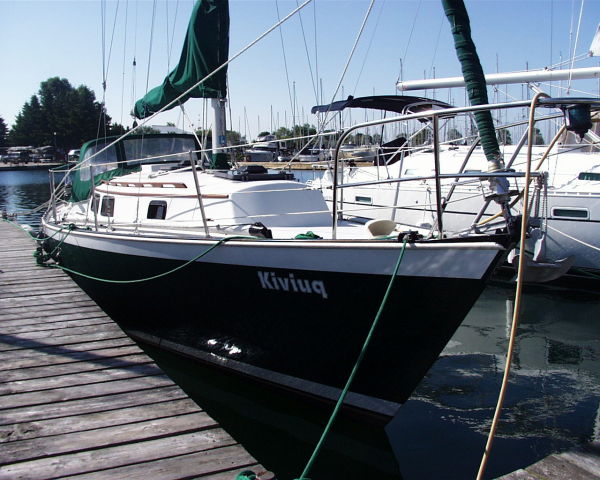
Hinterhoeller Niagara 31
- Toronto, ON
- CAD$ 25,000
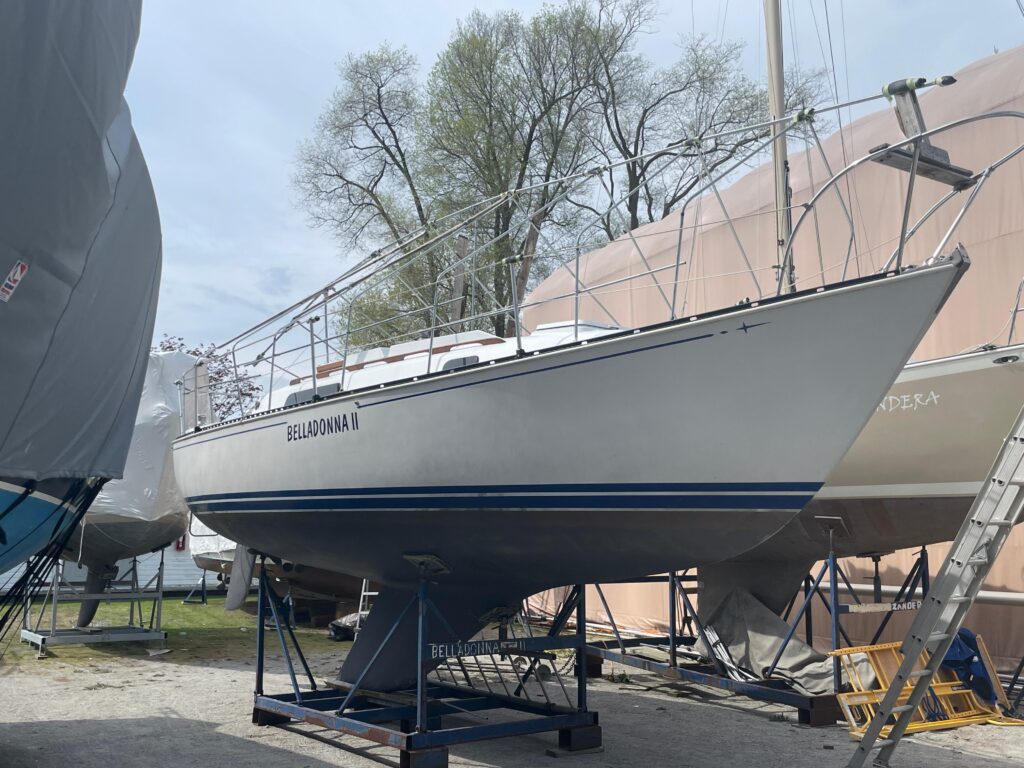
C&C 30 MkI

Alberg 29 Sloop
- Brockville, ON
- CAD$ 19,900
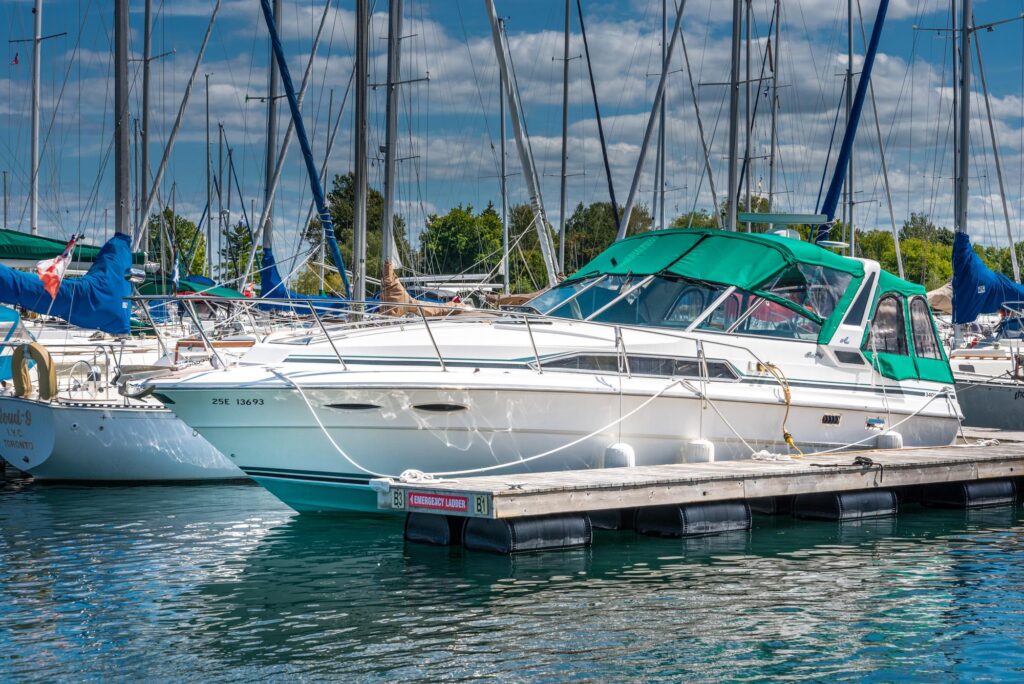
Sea Ray 340 Sundancer
- Thornbury, ON
- CAD$ 47,900
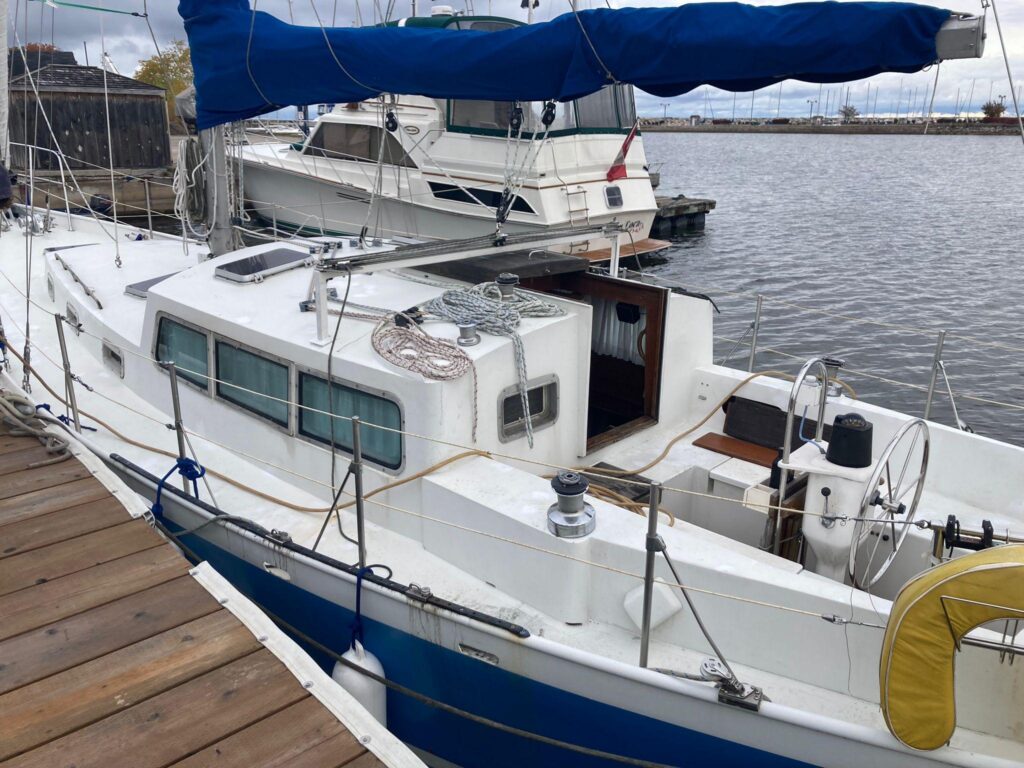
Brewer Pilothouse Cutter
- Hamilton, ON
- CAD$ 55,000

Our Latest from Instagram
- Lake Ontario and...
- Dave Harris
- 416-562-4856
- [email protected]
- Thousand Islands, Rideau Waterway and Eastern Ontario
- Grant and Pat Bowlby
- 613-331-5944
- [email protected]
- Georgian Bay
- 705-529-9433
- [email protected]
- South Western Ontario
- George Ayers
- 226-932-6974
- [email protected]
- Lake Simcoe, Toronto and the GTA
- John Heintzman
- 416-435-5029
- [email protected]
- Western Georgian Bay and Bruce Peninsula
- 226-791-2881
- [email protected]
- Southwestern Ontario
- 519-751-9656
- [email protected]

© 2024 Harris & Ellis Yachts. All Rights Reserved


1979 Bayfield 29 Technical Specs
General data about bayfield 29.
| Brand | |
| Model | |
| Boat Type | |
| Category | |
| Year Of Production | |
| Condition (New/Used) | |
| Country | |
| Fuel (Gas/Diesel) | |
| Hull Material Used | |
| Length | |
| Selling Price | |
Engine and Power Specs
| Engine manufacturer | |
| Engine Series | |
| Engine Horsepower | |
| Engine Built Year |
Dimensions And Wieght
| LOA (Length Overall) | |
| Displacement (Weight) | |
| Boat Maximum Draft | |
| Beam Width |
Detailed Specifications
| Waste Water Tank | |
| Number of Heads (Watercraft) | |
| Gas Tank Size | |
| Drinking Water Tank |
Features And Equipments
Other equipments.
| Datamarine depth sounder |
| Construction |
Bayfield 29

More 29 models
- Bayfield provided us with the latest version of its 29 service repair manual
- Find All mechanical and electrical parts and accessories of Bayfield 29 Sail here
Bayfield 29 competitors
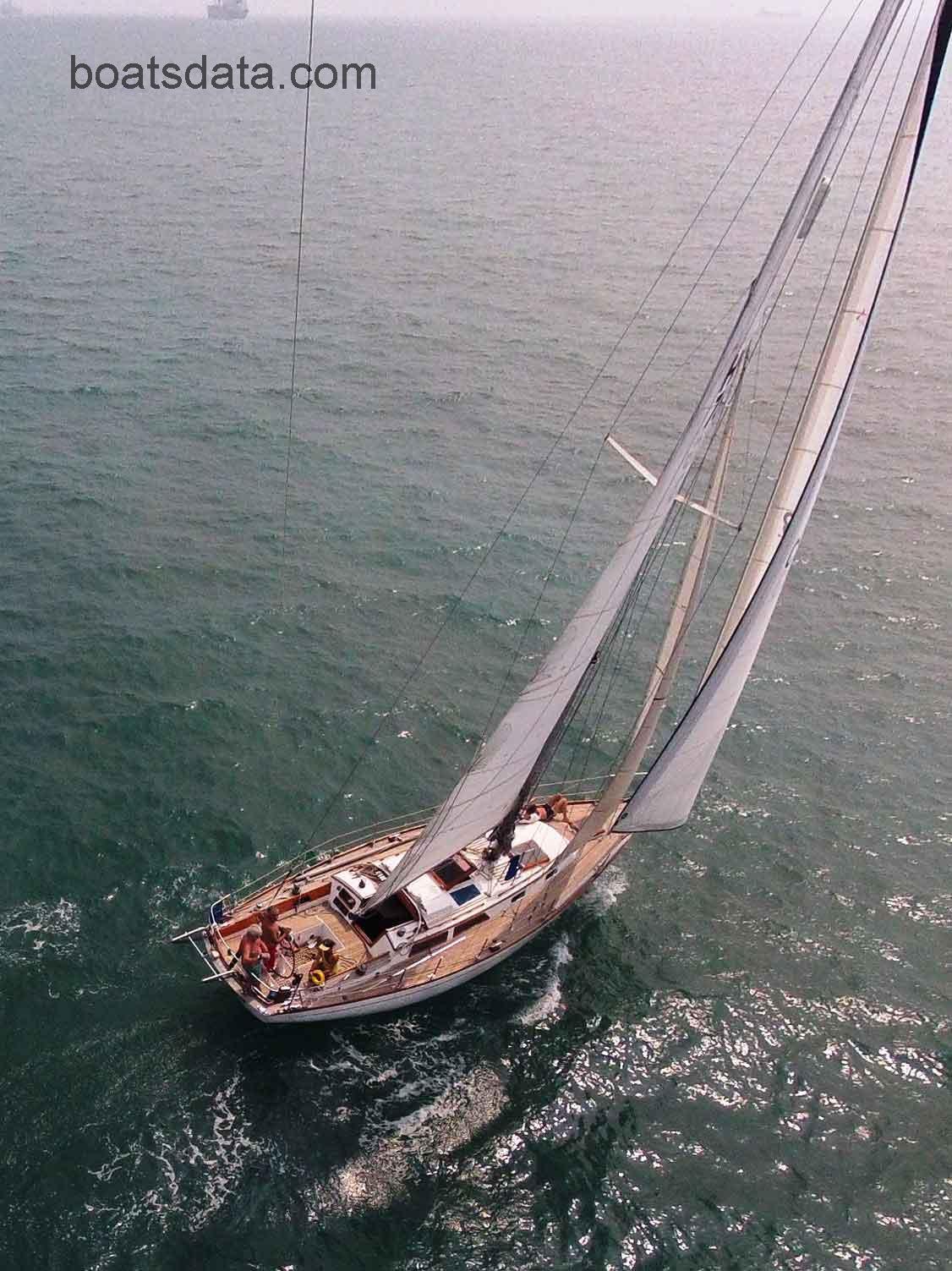
Island Packet


Share This Boat Listing
29' 1988 Bayfield 29***SOLD***
| Type: | Sailboat | Year: | 1988 | Make: | Bayfield |
|---|---|
| Model: | 29***SOLD*** |
| Length: | 29' |
| Status: | Sold | Price: | $ 24,900 | Location: | Cobourg, ON |
|---|---|
| Date Posted: | 2015-04-22 |

Contact the Broker
Red fields are required
Bayfield 29Â For Sale
Location: cobourg, ontario.
Broker: Adrian Philpot 613 985 3600 or [email protected]
The Bayfield 29 has a full keel, cutter rig (two head sails), a shallow draft, and a built-in bowsprit (complete with stylized wooden trail boards on either side of its bow). It is an out-and-out cruising boat and regarded as capable of offshore passages.
A unique feature of the Bayfield 29 is that it has no V-berth, which, on some boats, can be cramped and difficult to get in and out of. Instead, the Bayfield 29 has a huge and comfortable head where the v-berth is normally found. It does, however, have two quarter berths, as well as two berths in main cabin, one of which converts into a double. The Bayfield 29’s cabin is wide open, but built-in wooden panels which slide up from the galley counter and the chart table (a nicely executed idea) can be used to divide the living space into two areas.
This Bayfield 29 has unique tall-mast option, with mast and all rigging for Bayfield 32′ as purchased at the Toronto Boat Show by the first owner. Currently on her second owner, she is a well maintained late model Bayfield with a clean Yanmar diesel. Regarded by some as having the perfect interior layout for a pocket cruiser.
Additional Specs, Equipment and Information:
Specs Keel: Full
Dimensions LOA: 29 ft 0 in Beam: 10 ft 2 in Maximum Draft: 3 ft 6 in Displacement: 7100 lbs Ballast: 3000 lbs
| Â |
| A unique feature of the Bayfield 29 is that it has no V-berth,The Bayfield 29 has a huge and comfortable head where the v-berth is normally found.  The Bayfield 29’s cabin is wide open, but built-in wooden panels which slide up from the galley counter and the chart table (a nicely executed idea) can be used to divide the living space into two areas. |
| Â |
The Company offers the details of this vessel in good faith but cannot guarantee or warrant the accuracy of this information nor warrant the condition of the vessel. A buyer should instruct his agents, or his surveyors, to investigate such details as the buyer desires validated. This vessel is offered subject to prior sale, price change, or withdrawal without notice.
Buy and Sell with confidence using United City Yachts Industry leading Partner Network
With our partners at Walker Financial

Cross border transactions
Buy/Sell in the USA leveraging our partnership with Livingston International

Protect your funds
All transactions handled via a dedicated trust account at Baker Tilly, an internationally recognized accounting firm

Great choice! Your favorites are temporarily saved for this session. Sign in to save them permanently, access them on any device, and receive relevant alerts.
- Sailboat Guide
1982 Bayfield 29
- Description
Seller's Description
This is a 1982 Bayfield 29 sailboat which is completely equipped for comfortable cruising. Perfect for the Pacific Northwest, the Bayfield is also built for Blue Water sailing. She has a 3/4 keel that completely protects the rudder and propeller. The Bayfield is power by a Yanmar diesel that is in very good condition.
The Bayfield is a high quality build with a very unique design. The location of the head in the bow and the bulkheads are designed with a vertical “pocket door”. It is a wonderful layout that opens up the boat for ventilation and yet allows for privacy as needed. The head is designed as a wet locker for sails and has excellent storage for your sails as well as access to the anchor locker.
The salon has a folding centerline table with settees on both sides. The center of the table has a storage area for silverware and wine. The starboard settee can be extended for a double berth.
The galley is L-shaped and has many upgrades. The aft end of the salon has an extended countertop that can be folded up or down. Portside is the nav station along with a nicely sized quarter berth. The front side of the berth can be moved making a comfortable seat for the nav station.
Rig and Sails
Auxilary power, accomodations, calculations.
The theoretical maximum speed that a displacement hull can move efficiently through the water is determined by it's waterline length and displacement. It may be unable to reach this speed if the boat is underpowered or heavily loaded, though it may exceed this speed given enough power. Read more.
Classic hull speed formula:
Hull Speed = 1.34 x √LWL
Max Speed/Length ratio = 8.26 ÷ Displacement/Length ratio .311 Hull Speed = Max Speed/Length ratio x √LWL
Sail Area / Displacement Ratio
A measure of the power of the sails relative to the weight of the boat. The higher the number, the higher the performance, but the harder the boat will be to handle. This ratio is a "non-dimensional" value that facilitates comparisons between boats of different types and sizes. Read more.
SA/D = SA ÷ (D ÷ 64) 2/3
- SA : Sail area in square feet, derived by adding the mainsail area to 100% of the foretriangle area (the lateral area above the deck between the mast and the forestay).
- D : Displacement in pounds.
Ballast / Displacement Ratio
A measure of the stability of a boat's hull that suggests how well a monohull will stand up to its sails. The ballast displacement ratio indicates how much of the weight of a boat is placed for maximum stability against capsizing and is an indicator of stiffness and resistance to capsize.
Ballast / Displacement * 100
Displacement / Length Ratio
A measure of the weight of the boat relative to it's length at the waterline. The higher a boat’s D/L ratio, the more easily it will carry a load and the more comfortable its motion will be. The lower a boat's ratio is, the less power it takes to drive the boat to its nominal hull speed or beyond. Read more.
D/L = (D ÷ 2240) ÷ (0.01 x LWL)³
- D: Displacement of the boat in pounds.
- LWL: Waterline length in feet
Comfort Ratio
This ratio assess how quickly and abruptly a boat’s hull reacts to waves in a significant seaway, these being the elements of a boat’s motion most likely to cause seasickness. Read more.
Comfort ratio = D ÷ (.65 x (.7 LWL + .3 LOA) x Beam 1.33 )
- D: Displacement of the boat in pounds
- LOA: Length overall in feet
- Beam: Width of boat at the widest point in feet
Capsize Screening Formula
This formula attempts to indicate whether a given boat might be too wide and light to readily right itself after being overturned in extreme conditions. Read more.
CSV = Beam ÷ ³√(D / 64)
This listing is presented by PopYachts.com . Visit their website for more information or to contact the seller.
View on PopYachts.com
Embed this page on your own website by copying and pasting this code.
Similar Sailboats For Sale

1986 Bayfield 29C
- About Sailboat Guide
©2024 Sea Time Tech, LLC
This site is protected by reCAPTCHA and the Google Privacy Policy and Terms of Service apply.
Boat Reviews
- Boats Specs
- Marine Pros
- Boat Insurance
- Boat Warranties
- Boat Transport
- Boat Towing
- Marine Forecasts

Your Ultimate Boating Resource

1982 Bayfield 29
1982 bayfield 29 specs.
- Boat Type : Monohull Sailboats
- Quantity: 1
- Horse Power: 12
- Type: Diesel
- Hull Material : Fiberglass
- Beam : 10'2"
- Length : 29'
- Net Weight : 7350 lbs
- Looking for the Boat Manual? 1982 Bayfield Boats 29 Request Boat Manual Now
Related Boats
- 1977 Bayfield 29
- 1978 Bayfield 29
- 1979 Bayfield 29
- 1980 Bayfield 29
- 1981 Bayfield 29
- 1983 Bayfield 29
- 1984 Bayfield 29
- 1985 Bayfield 29
- 1986 Bayfield 29
- 1987 Bayfield 29
- 1988 Bayfield 29
Overview of the 2024 Sea-Doo RXP-X 325
Overview of the 2024 parker offshore 2900 cc, what your boat’s beam is and why it matters, power cats of 2024: ultimate guide to the top power catamarans this year, navigating the heat: 10 safety tips for a safe boat ride in the summer heat, what type of wood is used for pier pilings, what is the difference between a dock and a floating pier, what is the proper technique for pulling a beginner wakeboarder, what does ‘no wake’ mean on a lake, what is the difference between wash and wake, highs, lows, and tidal know-how: a deep dive into ocean currents, 10 essential tips for fishing near private property, the benefits of using a drift sock: guidance for anglers, lure fishing: secrets for imitating live bait and attracting fish, explore the untapped depths of america’s best bass fishing spots, outboard motor maintenance: tips for keeping your engine in top shape, the essential boat tool kit: tools every boater needs, diy boat building: 8 tips and tricks for building your own vessel, the art of miniature maritime craftsmanship: ship in a bottle, antifouling paints: a guide to keeping your boat shipshape, beginner’s guide to standup paddle boarding: tips and techniques, boating for fitness: how to stay active on the water, kayak safety: how to stay safe on the water, anchoring in a kayak or canoe: how to secure your small boat, overview of the 2024 yamaha 252sd, overview of the 2024 tiara yachts 48 le, overview of the 2024 bass cat jaguar sts, 2024 pursuit os 445: an overview, 2024 aquila 47 molokai review, 2024 sea-doo switch 13 sport review, gear reviews, megabass oneten max lbo jerkbait review, fortress anchors fx-7 anchoring system review, fortress anchors fx-11 anchoring system review, fortress anchors commando anchor kit review, fortress anchors aluminum anchors review, stay in touch.
To be updated with all the latest news, offers and special announcements.
- Privacy Policy
| : 213 |
Visit our Popular Forums
- Monohull Sailboats
- Multihull Sailboats
- Powered Boats
- General Sailing
- Antares Yachts
- Fountaine Pajot
- Lagoon Catamarans
Cruising Business
- Boat Classifieds
- General Classifieds
- Crew Positions
- Commercial Posts
- Vendor Spotlight
Life Aboard a Boat
- Provisioning: Food & Drink
- Families, Kids, & Pets Afloat
- Recreation, Entertainment, & Fun
- Boat Ownership & Making a Living
- Liveaboard's Forum
Seamanship, Navigation & Boat Handling
- Seamanship & Boat Handling
- Training, Licensing, & Certification
- Health, Safety, & Related Gear
- Rules of the Road, Regulations, & Red Tape
Engineering & Systems
- Const. / Maint. / Refit
- Product / Service Reviews
- Electronics: Comms / AV
- Electrical: Batts / Gen / Solar
- Lithium Power Systems
- Engines & Propulsion
- Propellers & Drive Systems
- Plumbing / Fixtures
- Deck Hdw: Rigging / Sails
- Aux. Equipment & Dinghy
- Anchoring & Mooring
Photo Categories
- Member Galleries
- Life Onboard
- Sailing in the Wind
- Power Boats
- Cruising Destinations
- Maint. & Boat Building
- Marine Life
- Scuba Diving & Divers
- General Photos
Recent Photos

Listing Categories
- African Cats
- view more »
- Crew Wanted
- Crew Available
- Enhance Your Account
- Meet the Mods
- Meet the Advisors
- Signup for The Daily Cruiser Email

IMAGES
COMMENTS
Sailboat Specifications Definitions Hull Type: Long Keel: Rigging Type: Cutter: LOA: 29.00 ft / 8.84 m: LWL: 21.75 ft / 6.63 m: S.A. (reported): ... The design of the Bayfield 29, as well as documentation from Bayfield, indicates a displacement of 7,100 pounds. However, we have seen that Bayfield's president at the time was quoted as saying the ...
Bayfield 29 is a 29′ 0″ / 8.8 m monohull sailboat designed by Ted Gozzard and built by Bayfield Boat Yard Ltd. between 1980 and 1983. Great choice! Your favorites are temporarily saved for this session. Sign in to save them permanently, access them on any device, and receive relevant alerts. ... Bayfield 29 is a 29 ...
The Bayfield 29 is a Canadian sailboat that was designed by Ted Gozzard as a cruiser and first built in 1978. [1] [2] Production. The design was built by the Bayfield Boat Yard in Canada from 1978 to 1983, with 350 boats completed, but it is now out of production. [1] [3] Design
The Bayfield 29 is a 29.0ft cutter designed by Ted Gozzard and built in fiberglass by Bayfield Boat Yard Ltd. (CAN) between 1978 and 1983. 350 units have been built. The Bayfield 29 is a heavy sailboat which is a good performer. It is very stable / stiff and has a low righting capability if capsized. It is best suited as a coastal cruiser.
If you are a boat enthusiast looking to get more information on specs, built, make, etc. of different boats, then here is a complete review of BAYFIELD 29. Built by Bayfield Boat Yard Ltd. (CAN) and designed by Ted Gozzard, the boat was first built in 1978. It has a hull type of Long Keel and LOA is 8.84. Its sail area/displacement ratio 20.33.
The bow sections are fairly full, and the beam compares with those of some larger performance-oriented yachts. The design of the Bayfield 29 specifies a displacement of 7,100 pounds. Bayfield's president, Jake Rogerson, notes that the boat is actually built heavier and stronger than called for, which places its actual displacement around ...
The DL-ratio for Bayfield 29 is 307 which categorizes this boat among 'medium weight cruisers'. Heavy Light 27% 0 50 100. 27% of all similar sailboat designs are categorized as heavier. A heavy displacement combined with smaller water plane area has lower acceleration and is more comfortable.
The Bayfield 29 is a recreational keelboat, built predominantly of fibreglass, with wood trim. It has a cutter rig with anodized aluminum spars, a clipper bow, a conventional transom, a keel-mounted rudder controlled by a tiller, or optional Edson wheel, and a fixed long keel. The design has no provisions for a spinnaker and has been noted as having a small cockpit. It has a book displacement ...
Bayfield 29 — An early review. I've had a few weeks with the new boat (Bayfield 29, la Princesa …until I change the name in a few weeks), and I'm getting a good feel for her. Firstly, I don't have any buyers remorse. At least not yet. I'm rather pleased with the design in general.
Anyone wanting a fine cruising boat & is prepared to do a good cleanup will have a wonderful final product. Specifications. Length: 29ft; Beam: 10' 0" Year: 1980; Hull: Fiberglass; ... Bayfield 29 29ft CAD$ 9,500 Collingwood, ON, CA. Ewan Campbell. Mobile: 705-529-9433 ...
Data And technical specifications of Bayfield 29 equipments, fuel economy, dimensions, weight, engine power and prices . Sea Ray; ... Bayfield models ; 29 specifications; 1980 Bayfield 29 Technical Specs. General Data about Bayfield 29. Brand: Bayfield: Model: 29: Boat Type: Sail: Category: Cutter: Year Of Production: 1980: Condition (New/Used ...
Get the latest 1978 Bayfield 29 boat specs, boat tests and reviews featuring specifications, available features, engine information, fuel consumption, price, msrp and information resources.
Data And technical specifications of Bayfield 29 equipments, fuel economy, dimensions, weight, engine power and prices . Sea Ray; ... Bayfield models ; 29 specifications; 1979 Bayfield 29 Technical Specs. General Data about Bayfield 29. Brand: Bayfield: Model: 29: Boat Type: Sail: Category: Cutter: Year Of Production: 1979: Condition (New/Used ...
Location: Cobourg, Ontario. Broker: Adrian Philpot 613 985 3600 or [email protected]. The Bayfield 29 has a full keel, cutter rig (two head sails), a shallow draft, and a built-in bowsprit (complete with stylized wooden trail boards on either side of its bow). It is an out-and-out cruising boat and regarded as capable of offshore ...
Hull Material: Fiberglass. Beam: 10'2". Length: 29'. Net Weight: 7350 lbs. Looking for the Boat Manual? 1986 Bayfield Boats 29. Request Boat Manual Now. Get the latest 1986 Bayfield 29 boat specs, boat tests and reviews featuring specifications, available features, engine information, fuel consumption, price, msrp and information resources.
Eco-Friendly: Electric boat motors produce zero emissions, protecting our waterways. ... Bayfield 29 Specifications. Hull Type: Long Keel Rigging Type: Cutter LOA: 29.00 ft LWL: ... Below is a performance projection for the Bayfield 29. A typical battery consists of a 48Vdc x 200Ah AGM or LiFePO4 battery driving an Electric Yacht 10 kW motor.
Find Bayfield 29 boats for sale in your area & across the world on YachtWorld. Offering the best selection of Bayfield boats to choose from.
Seller's Description. This is a 1982 Bayfield 29 sailboat which is completely equipped for comfortable cruising. Perfect for the Pacific Northwest, the Bayfield is also built for Blue Water sailing. She has a 3/4 keel that completely protects the rudder and propeller. The Bayfield is power by a Yanmar diesel that is in very good condition.
Get the latest 1979 Bayfield 29 boat specs, boat tests and reviews featuring specifications, available features, engine information, fuel consumption, price, msrp and information resources. BoatingWorld Discover the World of Boating. Your Ultimate Boating Resource ...
Get the latest 1982 Bayfield 29 boat specs, boat tests and reviews featuring specifications, available features, engine information, fuel consumption, price, msrp and information resources. ... 1982 Bayfield 29 Specs. Boat Type: Monohull Sailboats; Engine Specifications. Quantity: 1; Horse Power: 12; Type: Diesel; Hull Material: Fiberglass ...
Specifications: L.O.A.: 29' 0" (8.84 m) L.W.L.: 21' 9" (6.60 m) Beam: 10' 2" (3.10 m) ... It is an out-and-out cruising boat, and like its smaller counterpart, the Bayfield 25, it only starts to come alive when the winds picks up. ... have two quarter berths, as well as two berths in main cabin, one of which converts into a double. The Bayfield ...
Location: Thunder Bay, Ontario - 48-29N x 89-20W. Boat: (Cruiser Living On Dirt) Posts: 50,114. Images: 241. BAYFIELD REVIEWS from Candian Yachting": Bayfield 29: For the traditionalists ~ by Brian Gooderham and Carol Nickel. Canadian Yachting. Bayfield 32: From Family Cruiser to the OSTAR ~ By Paul Howard.